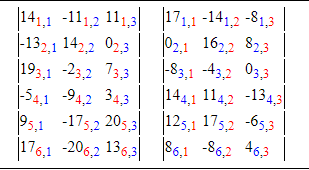- Adding/subtracting matrices
- Multiplying matrices
- Multiplying/dividing matrix elements by a constant or variable
- Finding the determinant of a matrix
Each matrix has six rows and three columns, allowing them to be added/subtracted. When we add/subtract, we would add/subtract the entries in the corresponding locations, forming a new matrix of the same dimensions as the original two matrices. Multiplying matrices requires that the number of columns in the first matrix match the number of rows in the second matrix. Since the first matrix above has three columns and the second matrix has six rows, we cannot multiply the above matrices. We, however, can multiply the matrices below.
In order to perform the multiplication, we multiply each column in the second matrix by each row in the first matrix. Each such product of a column and a row produces a single number. (The first number, placed in the first row and the first column, would be -9*19 + -2*18 + 2*-19 = -245. The second number, placed in the second row and first column, would be -9*-3 + -2*8 + 2*-5 = 1.) The resulting product matrix will have the same number of rows as the first matrix and the same number of columns as the second matrix. The product matrix above would have six rows and five columns. The two matrices below cannot be multiplied (columns of the first do not match rows of the second), showing that matrix multiplication is not commutative.
When a single term appears outside of a matrix, you simply multiply all elements within the matrix by that value or term.
The determinant of a matrix determines whether the system defined by the matrix has a unique solution. If the determinant is non-zero, there is a unique solution to the system. In order for a matrix to have a determinant, it must be a square matrix - its number of rows must match its number of columns. Both of the matrices below have determinants.
The determinant of the second matrix is 6*14 - 5*7 = 84 - 35 = 49. The determinant of the first matrix is 13*(-2)*(-6) + 10*12*(-3) + (-6)*16*12 - (-6)*(-2)*(-3) - 10*16*(-6) - 13*12*12 = 156 + -360 + -1152 - -36 - -960 - 1872 = 156 - 360 - 1152 + 36 + 960 - 1872 = -2232. A full explanation for how to calculate determinants for larger matrices is beyond what you will need to know for the ACT/SAT.




No comments:
Post a Comment